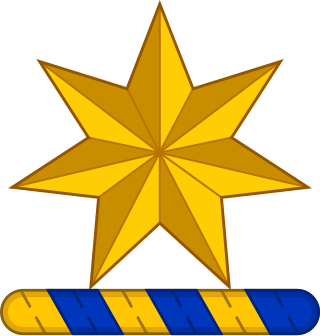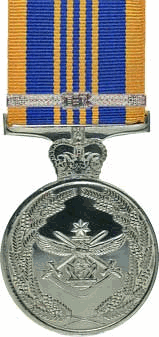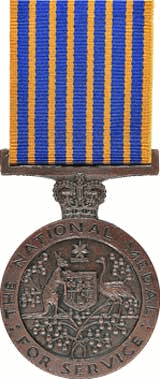The Australian honours and awards system refers to all orders, decorations, and medals, as instituted by letters patent from the Monarch of Australia and countersigned by the Australian prime minister at the time, that have been progressively introduced since 14 February 1975. The Australian honours and awards system excludes all state and local government, and private, issued awards and medals.

The Commonwealth Star is a seven-pointed star symbolising the Federation of Australia which came into force on 1 January 1901.

The Alberta Centennial Medal is a commemorative medal celebrating Alberta's first 100 years as a province of Canada.
The Medal for Gallantry(MG) is a military decoration awarded to personnel of the Australian Defence Force. It recognises acts of gallantry in action in hazardous circumstances. The MG was introduced on 15 January 1991, replacing the Imperial equivalent. It is ranked third in the Gallantry Decorations in the Australian Honours System. Recipients of the Medal of Gallantry are entitled to use the post-nominal letters "MG".
The Australian Sports Medal is an award given to recognise achievements in Australian sport to commemorate Australian participation in major sporting events. Original recipients of the award included competitors, coaches, sports scientists, office holders, and people who maintained sporting facilities and services. During the original period of its award in 2000–2001, over 18,000 medals were awarded. The award was permanently reactivated in 2020 to commemorate Australian contributions and participation in major multi-sport events.

The Humanitarian Overseas Service Medal is an award in the Australian honours system. The award is presented to those who perform humanitarian service in a foreign country, in particular those working in dangerous environments or conditions or during a humanitarian crisis. The award was introduced by letters patent on 16 April 1999, following a review of the Australian honours and awards system beginning in 1995.

The Defence Force Service Medal (DFSM) is an Australian Military award given for long service by permanent members of the Australian Defence Force. It is part of the suite of defence force service awards introduced in 1982, which also included the Reserve Force Decoration and the Reserve Force Medal.

The Defence Long Service Medal is an Australian military award given for long service by permanent and reserve members of the Australian Defence Force (ADF), irrespective of rank. It was introduced in 1998, and replaced the suite of ADF service awards introduced in 1982, which comprised the Defence Force Service Medal, the Reserve Force Medal and the Reserve Force Decoration.

The National Medal is an Australian award given for long service by operational members of specified eligible organisations. It was introduced in 1975, as an original component of the new Australian honours system, and replaced a range of medals available to military and civilian uniformed services for long service and good conduct. The eligible groups have in common that their members serve or protect the community at the risk of death, injury or trauma, hence it is only available to members of the eligible organisations who are operationally deployed. In the case of corrective services, eligibility is restricted to officers with custodial duties.
The Public Service Medal (PSM) is a civil decoration awarded to Australian public servants for outstanding service. The PSM was introduced in 1989 and replaced the Imperial awards discontinued in 1975, supplementing the Order of Australia introduced that same year. Recipients of the Public Service Medal are entitled to use the post-nominal letters "PSM".
The Australian Police Medal (APM) is awarded for distinguished service by a member of an Australian police force. The APM was introduced in 1986, and replaced the Imperial King’s Police Medal for Gallantry and King’s Police Medal for Distinguished Service.
The Australian Fire Service Medal (AFSM) is awarded for distinguished service by a member of an Australian fire service. The AFSM was introduced in 1988, and replaced the Imperial awards of the Queen's Fire Service Medal for Gallantry and the Queen's Fire Service Medal for Distinguished Service. Recipients of the Australian Fire Service Medal are entitled to use the post-nominal letters "AFSM".
The Emergency Services Medal (ESM) is awarded for distinguished service by a member of an Australian emergency service, and people who are involved in emergency management, training or education. The medal was introduced in 1999, and recipients are entitled to use the post-nominal letters "ESM".
The Police Overseas Service Medal is an award in the Australian honours system. The award is presented to members of an Australian police force in recognition of service undertaken with an international peace-keeping organisations or following a request for assistance from a foreign government. The award was introduced by letters patent on 25 April 1991. In 2013 the criteria were amended to also include service by regular and patrol officers of the Royal Papua New Guinea Constabulary. Recipients of the medal are not entitled to any post-nominal letters.

The Australian Cadet Forces Service Medal is awarded to recognise long and efficient service by officers and instructors in the Australian Defence Force Cadets. It is awarded for 15 years service. Additional clasps are issued for every 5 years additional service.

Brian David Outram Anderson is Professor in the Research School of Information Sciences and Engineering at the Australian National University. His research interests include circuits, signal processing and control, and his current work focuses on distributed control of multi-agent systems, sensor network localization, adaptive and non-linear control. Professor Anderson served as President of the Australian Academy of Science from 1998 to 2002.

The National Police Service Medal (NPSM) is a special service award within the Australian honours system to provide "recognition for the unique contribution and significant commitment of those persons who have given ethical and diligent service as a sworn member of an Australian police service".
The National Emergency Medal is an award of the Australian honours system given for sustained service during a nationally significant emergency; or to other persons who rendered significant service in response to such emergencies. The medal was established by Queen Elizabeth II in October 2011. The medal is awarded for events specifically set out by regulation or may be awarded upon the recommendation of the National Emergency Medal Committee for significant service.
The Badge of Honour, accompanied by the King's Certificate and Badge of Honour, is a civil award previously presented by the governments of British colonies and protectorates, and now by British Overseas Territories, to recognise loyal and valuable service by native chiefs and other non-European dignitaries. The Badge of Honour and Certificate continue to be awarded for meritorious services to the local community of an exceptional or outstanding nature in Gibraltar, the Falkland Islands, the Cayman Islands, Bermuda and St Helena.
The Australian Intelligence Medal (AIM) is a civil decoration awarded to national intelligence community members for distinguished service. The decoration was introduced on 24 January 2020. Recipients of the Australian Intelligence Medal are entitled to use the post-nominal letters "AIM".









